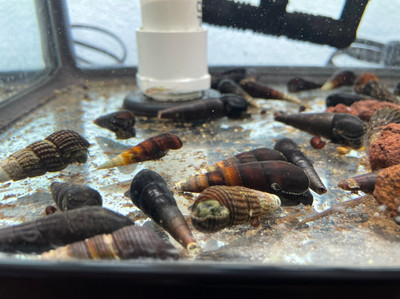The Fascinating World of Rabbit Snails: Nature's Curious Aquatic Explorers
Posted by Max Gandara on on 2nd Jun 2023
The Fascinating World of Rabbit Snails: Nature's Curious Aquatic Explorers
The rabbit snail (Tylomelania spp.) is a remarkable and captivating
species of freshwater snail known for its peculiar appearance and
intriguing behavior. Native to the freshwater lakes and rivers of
Sulawesi, Indonesia, these snails have become popular among aquarium
enthusiasts due to their unique characteristics and ability to coexist
with a variety of fish species. In this article, we will delve into the
intriguing world of rabbit snails, exploring their physical features,
habitat, behavior, and care requirements.
Physical Features:
Rabbit snails are relatively large snails, with their size ranging from 2
to 4 inches (5 to 10 cm) in length. Their most distinctive feature is
their elongated and cone-shaped shell, resembling a rabbit's ear or
horn. The shell typically displays an intricate pattern of varying
colors, including shades of yellow, brown, and black. These colors help
them blend into their natural environment, providing camouflage from
potential predators.
Habitat and Distribution:
Rabbit snails are endemic to the freshwater lakes, rivers, and streams
of Sulawesi, an island in Indonesia. They are specifically found in the
Malili lake system, which encompasses Lake Matano, Lake Towuti, Lake
Mahalona, and Lake Masapi. These snails thrive in slow-moving or
stagnant water with a pH range of 7.0 to 8.0, and a temperature between
75°F and 82°F (24°C to 28°C). They inhabit areas with sandy or muddy
substrates and are often found near aquatic vegetation or fallen leaves.
Behavior and Feeding:
Rabbit snails are renowned for their distinct and fascinating behavior.
They are primarily detritivores, meaning they feed on decaying organic
matter, such as plant debris, uneaten fish food, and dead aquatic
organisms. Their foraging activities help maintain the cleanliness of
the aquarium by consuming excess waste materials.
One of the most intriguing behaviors exhibited by rabbit snails is their
ability to breathe atmospheric air. They possess a specialized organ
known as a pallial lung, which allows them to extract oxygen from the
air when necessary. This adaptation allows rabbit snails to survive in
oxygen-deficient water conditions, such as during periods of heavy rain
or low water flow.
Reproduction and Lifespan:
Rabbit snails are simultaneous hermaphrodites, meaning each individual
possesses both male and female reproductive organs. However, they cannot
self-fertilize and require a mate for reproduction. During courtship,
the snails engage in a unique ritual that involves the exchange of
spermatophores. After successful mating, the female snail will lay
small, round-shaped eggs, which she buries in the substrate or attaches
to solid surfaces. The eggs hatch after a few weeks, and the juveniles
are independent from birth.
In captivity, rabbit snails have an average lifespan of around 2 to 3
years, although with proper care, they can live longer. It is important
to note that they are slow growers, and it can take up to a year for
them to reach their full adult size.
Care and Aquarium Requirements:
To provide a suitable environment for rabbit snails, it is crucial to
recreate their natural habitat within the aquarium. A tank with a
minimum capacity of 10 gallons (38 liters) is recommended to accommodate
their size and allow them ample space to explore. The water should be
kept clean, well-filtered, and maintained within the optimal temperature
and pH ranges mentioned earlier.

